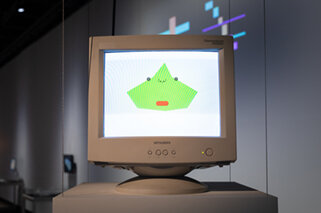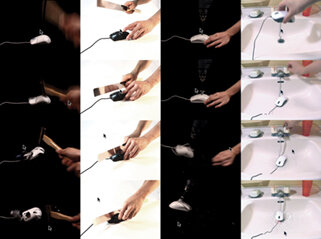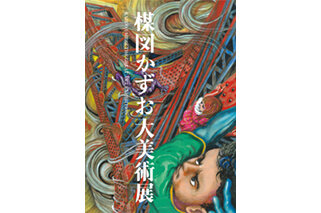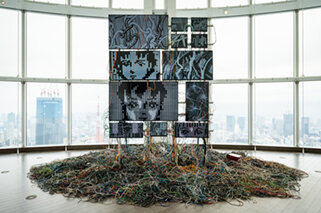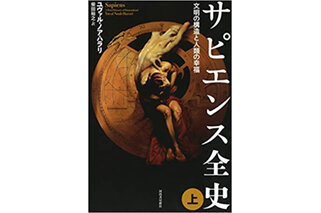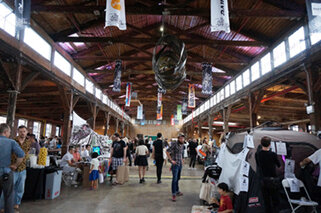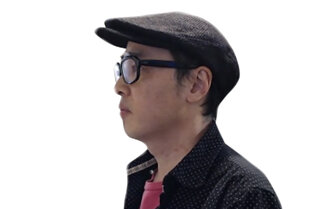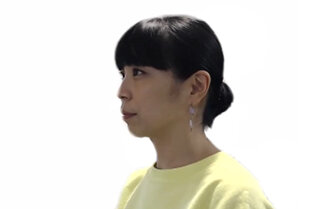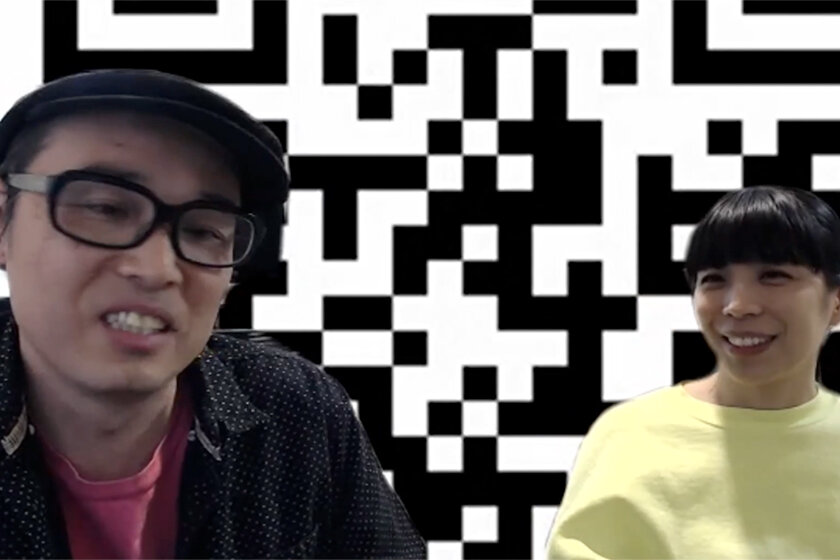
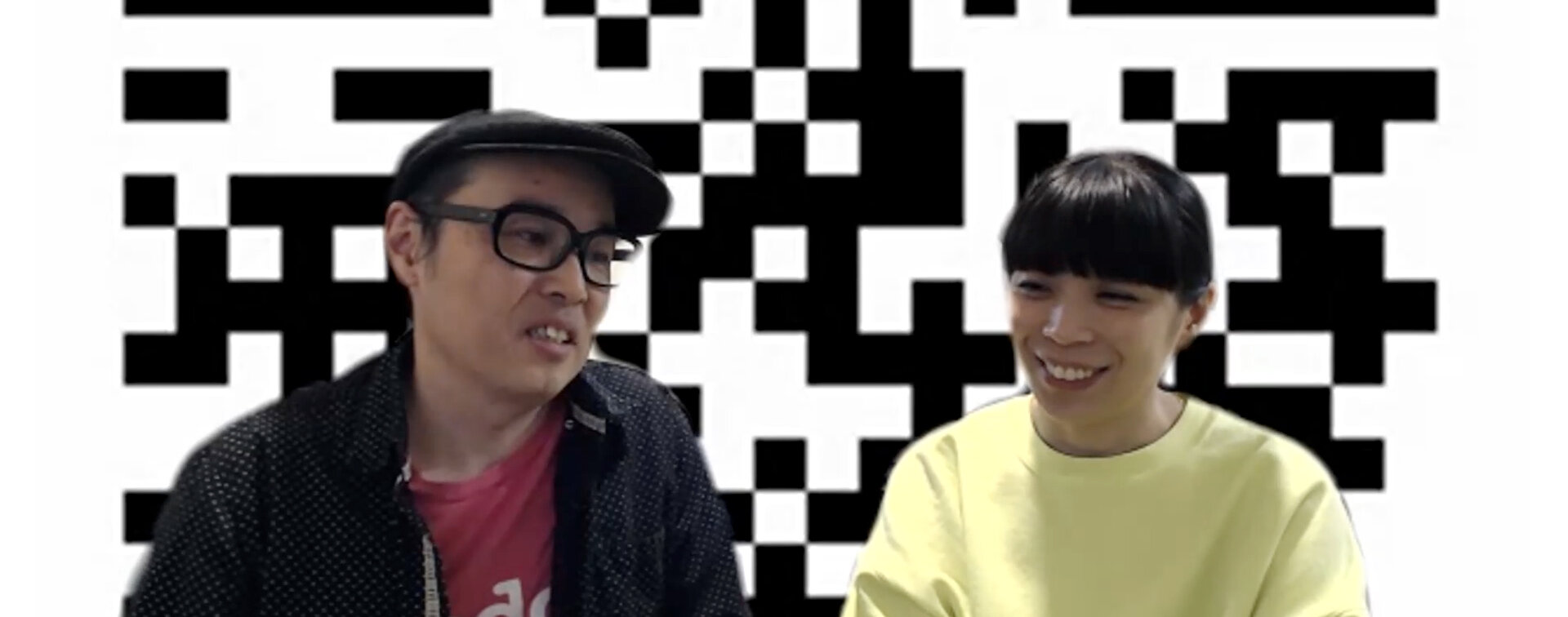
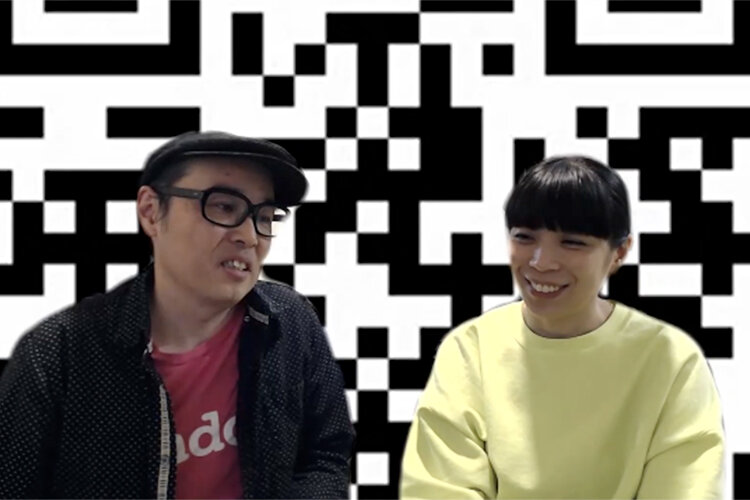
INTERVIEW
135
exonemoArtist Unit
Hosting a Totally Meaningless, Hyper Flashy Festival with no Distinction Between Men and Women, New and Old, or Aged and Young
A space filled with cross-border diversity and fantasy
Formed by Sembo Kensuke and Akaiwa Yae, exonemo is an artist unit currently based in New York. They have featured the internet in their art since the early ages of the internet, and engage in all kinds of endeavors including installations, performances, and hosting events. Currently, they have work displayed at the Kazuo Umezz the Great Art Exhibition on at Tokyo City View in Roppongi Hills. In an online interview between Tokyo and New York, we asked exonemo about the transition of the internet, which has been one of their central themes, their impression on recent technology such as NFTs and metaverses, and their experiences in New York City.
The line between reality and the everchanging internet
Sembo KensukeIn creating media art, I feel like we've always thought about boundary lines: ones between the virtual and the real, between digital and analog, between humans and robots, etc. The positioning of boundary lines are always being updated and change along with the times. When our unit started off, the internet was a special thing only used by early adopters, but now everybody uses it as a matter of course. In that way, boundary lines between two things are always shifting places or emerging anew somewhere else. Exploring where those boundary lines are has become somewhat of a style in our projects.
Akaiwa YaeIn the past, diving into the internet was a conscious moment of connection, where you would think, "I'm off!" before going in. In contrast, now it's like we always have one foot, or rather, both feet stuck in online. The boundary line between the internet and reality has become blurred in that sense, and I think that transition has been interesting.
I first started thinking about boundary lines when we exhibited work that had been shown online only in a physical space. We had never been interested in exhibitions because displaying art on a physical medium like paper, for example, meant having the work fixed on paper, which would also cost money. However, we ended up participating in an exhibition in the year 2000 due to happenstance, and seeing how work that had only existed in a virtual space on the internet could cross the boundary line into reality was an eye-opening experience.
KAO(1996)
exonemo's first foray into internet art. Like the children's game of fukuwarai, the interactive program allows visitors to position facial features as they want and submit a face to the server, where the face combines with another face to generate new "offspring." Until about the year 2000, exonemo mainly made art of this kind that could only be experienced on the web. In 2000, they participated in the Tech.Pop.Japan exhibition at the International Film Festival Rotterdam.
From the exonemo: UN-DEAD-LINK exhibition.
Source: Tokyo Photographic Art Museum Photo: Ryuichi Maruo
URL:http://www.exonemo.com/KAO/index.html
DanmatsuMouse (2007)
The work captures a computer mouse being destroyed in a video of the moment, as well as the movement of its cursor on the desktop. Incorporating both the physical in the form of the mouse and the digital in the form of the desktop, this work prompted exonemo to start making use of various media to create art in physical spaces as well.
The relationship between artist and exhibition, discovered through a fully remote installation process
SemboThe installation work Callbacks that we created for the Kazuo Umezz the Great Art Exhibition draws from Umezu's manga My Name is Shingo. Although it is a fairly old series, it points to present-day issues such as computers developing personalities and AI taking over jobs, which is in sync with the kind of work that we do, and the affinity was striking. The installation process for this exhibition was done fully remotely, but we felt no stress in doing that at all.
Doing things remotely is quite interesting, if you think about it. In a sense, art exhibitions are inherently done remotely. Historically speaking, artists couldn't go to a show to set up their work in person most of the time. Also, historic artists such as Picasso or Duchamp still have their work shown in exhibitions after their deaths, which are arguably exhibitions done remotely from the afterlife. Given that artwork is a medium through which artists convey a message, that's a kind of remote communication as well. I think there are a lot more new perspectives to explore when considering the relationship between the artist and the exhibition as well as between the artwork and the viewer, and I'm interested in that at the moment.
Kazuo Umezz the Great Art Exhibition
This exhibition focused on horror manga virtuoso Kazuo Umezu's most celebrated works, My Name is Shingo, The Drifting Classroom, and Fourteen, as well as the first showing of ZOKU-SHINGO Chiisa na Robot Shingo Bijutsukan (SHINGO CONTINUED: Small Robot Shingo Museum), Umezu's first new work in 27 years. The artists exonemo, Yuma Tomiyasu, and Tomoko Konoike also contributed to the exhibition. On at Tokyo City View until Tuesday, March 25, 2022.
URL:https://6mirai.tokyo-midtown.com/event/umezz_kazuo/index.html
Callbacks (2021)
An installation that displays scenes from the sci-fi manga series My Name is Shingo on multiple monitors. It also features physical objects from the series, such as Japanese school bags and Tokyo Tower. The installation brings an immersive experience of entering the world of the manga to life with exonemo's signature use of technology.
©exonemo ©Kazuo Umezu/Shogakukan
Photo: Ken Kato
AkaiwaBut some things were difficult to do remotely. Callbacks involved sound, but we couldn't do a sound check in person and we had a tough time making adjustments.
SemboThat's right. For example, we used Zoom to check in from New York, but the noise cancelling function worked too well and we couldn't hear anything from the installation space. In the end, we put our faith in the sensibilities of the excellent creative staff in Roppongi and left the settings up to them (laughs).
AkaiwaBut there were definitely some good things, too. We couldn't come back from New York for last year's solo exhibition CONNECT THE RANDOM DOTS held at WAITINGROOM either, and we did everything remotely. But not being able to go to the actual space cut down on the extraneous factors involved and we were able to present our work sharp and unadulterated from its initial concept. If we had actually been there, I think we would have added more to the concept as we went along.

NFTs are met with initial hesitancy, just like the internet
SemboWe tried incorporating NFTs in the CONNECT THE RANDOM DOTS exhibition, but opinions on NFTs are still very mixed, especially in the media art industry. Personally, I think NFTs still have a lot of problems, such as its toll on the environment for using too much power, but the blockchain technology itself that drives it is interesting, so I don't feel like denouncing it in particular.
CONNECT THE RANDOM DOTS
A solo exhibition held at the WAITINGROOM gallery in 2021. Inspired by "connect-the-dots" activities for kids, a book with the same title as the exhibition allows anyone to create abstract art simply by connecting dots that are randomly generated by a computer. Ownership of each page of the book was available for purchase as an NFT, with a website set up at the same time where owners could connect with each other.
URL:https://connect-the-random-dots.ooo
People believe in the security of the blockchain system because it's maintained by calculations done by computers all over the world. I think the fact that this alone has created an enormous amount of value is a symbolic representation of common perceptions born through the process of human evolution. What is deemed valuable, be it money or art, is influenced by human disposition, and the fact that this is being materialized as a system running on codes is fascinating. The way value suddenly appears out of nowhere also feels very "human." I think we are only seeing the prominent portions of blockchain and it still has much more room for exploration.
AkaiwaIn New York as well, artists are completely divided over the issue of NFTs. Some early advocates were really quick to use them and we were actually a little late to the party, but we figured we wouldn't know what it would be like unless we tried it. So we tried selling a few pieces of NFT art before our solo exhibition in Tokyo in auction format. Many of those who hate NFT art think that "the quality is lacking" or they "don't want to think of it as art," and I understand how they feel. But as long as we feel there's even a bit of potential it's much more interesting to dive in, and the atmosphere surrounding NFTs feels a bit like back in the early days of the internet.
Back in the early days, no once gave any attention to internet art, and nobody recognized it as art. Over time, internet art gradually took shape. In the same way, I think it's more interesting to be involved with NFT art from the inside with all the good and bad mixed together in one big mess, rather than watching it from the outside. It's been a while since something like this has happened on the internet.
SemboYes. The key is that people hate it (laughs).
The development of technology has to be with the nature of humankind
SemboCryptocurrency is basically a virtual form of money, right? In Sapiens: A Brief History of Humankind, Yuval Noah Harari argues that when humanity took a step forward in evolution, it acquired the ability to believe in imagined realities and fiction in what he termed the Cognitive Revolution. For example, religions and nations are virtual concepts, aren't they? So that means the internet was born in line with human cognitive capacity for virtual things, which can be dated way back to the beginning of human history. I believe the attempt to give virtual constructs to everything is inevitable and a fundamental nature of humankind. In that sense, it's no use worrying about change at this point.
Sapiens: A Brief History of Humankind
An overarching account of human history by Israeli historian and philosopher Yuval Noah Harari. A comprehensive look at human history on an epic scale from past to present, putting forth the argument that the key to why Homo sapiens flourished was the ability to believe in imagined concepts.
AkaiwaWe don't actually expect much from new technology in and of itself. I think everyone constantly hopes to change themselves in some way, and when technology meets those demands, people jump at the opportunity. But we don't know whether that will lead to good or bad things. You could argue that social media is what led to people like Trump.
SemboPerhaps it's healthier for both technology and society to fluctuate back and forth, and maybe it's more dangerous if things get stagnant. Facebook has become Meta and is pushing forward with the metaverse, but I imagine it might fail once and then finally materialize twenty years later or so. Once the pandemic is over, I'm sure everyone will want to get away from the virtual stuff and go out, and part of me thinks that by the summer no one will be interested in buying NFTs anymore. I think that kind of fluctuation is exactly where the source of energy is.

New York, a city where artists can be who they are
SemboWe've been living in New York City for the last six years, but we have so many artists around us, including parents at our kid's school and our landlord. It's a very diverse array of artists as well, so much that us making media art isn't all that conspicuous. It's so different from Japan that it was surprising at first.
AkaiwaIt was. In Japan, whenever I told other parents at our kid's preschool that we were artists, they would immediately be standoffish. Like they were wondering if we were weird (laughs). But over here, that kind of segregation doesn't happen and people don't put up walls just because we're artists. Also, the women over here are strong so they speak their mind, and there are plenty of female media artists, which makes my life easier.
Asides from that, we moved here just when contemporary art and media art were starting to converge. We had wanted to see more media art exhibited in big museums and in big auctions, so it was an interesting time to experience. I thought we were only going to be there for half a year or so, and I never imagined that we'd be here for six years.
SemboNew York is such that I sometimes think it must be the only place on earth that's this diverse. Of course there are problems too, but there are so many different ethnicities here. If there's another city like it I'd want to try living there as well.
AkaiwaNow that I think about it, there was a time in my thirties that I went to check out the SuperDeluxe art space in Roppongi, Tokyo almost every day. The people who gathered there were diverse, and I remember I really enjoyed going there.
The importance of having absolutely no meaning
SemboIf we were to do a project in Roppongi, I would want to try something that has absolutely no meaning rather than something that would benefit society. Recently, socially engaged art (SEA) has been a trend, highlighting art involved with social contributions. I don't mean to criticize that, but I do think it's also important to have art that holds no meaning in the activities of human society. I was talking with huez, a team we know that does spatial effects design for stages and stuff, and we were saying how it would be great to do a really ridiculous installation using lasers and projectors. I feel like that kind of thing would work in Roppongi.
huez
A visual & lighting team affiliated with SHIBUCITY Inc. that designs technology-driven spatial effects using lasers and projectors. Team members include programmers, engineers, video jockeys, videographers, lighting designers, and directors. The team also does effects for virtual live performances online.
AkaiwaI guess I'm looking for diversity. It might be interesting if there are still places like that in Roppongi. If we had to do something, maybe a festival (laughs)? The city of Roppongi has some distinctive old-town areas if you go as far as Azabu Juban. It has hills that Tamori-san (a TV personality with a weekly show where he wanders around exploring neighborhoods) would love, that turn into residential areas if you keep going. I think Roppongi's mix of old and new townscapes is interesting, so I would want to incorporate going through the old neighborhoods to lead into the glitzy part of Roppongi.
SemboI guess if you combine the two ideas, it would be like a totally meaningless, hyper flashy festival (laughs). A festival that simply makes people go wild, regardless of gender or age or if they're new or old (laughs). You go wild, and then when you look back on ordinary life from a non-ordinary perspective, you might notice a bunch of things. That effect would be part of it, too.
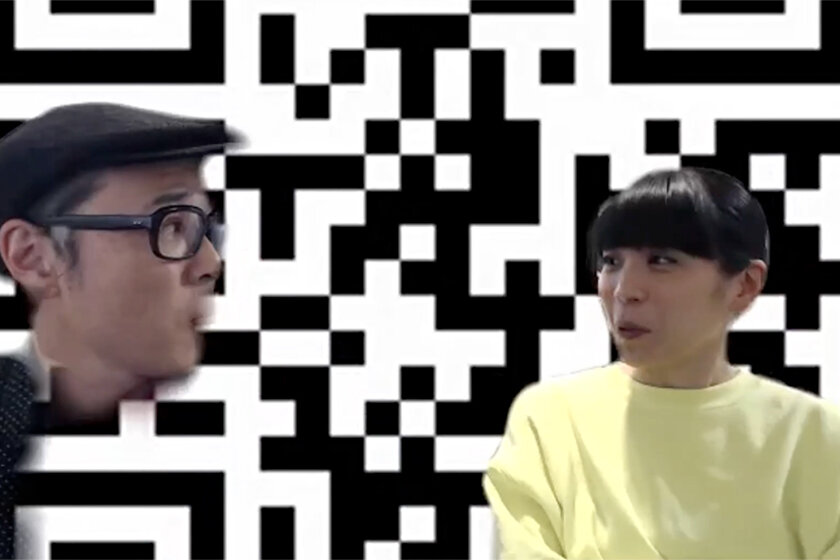
Differences born out of the relationship between the internet and cities
AkaiwaSpeaking of cities, we've been putting on an event called Internet Yami-Ichi (Black Market) for about ten years. We've made it an open platform so that anyone in any city can host one as long as they go along with the concept, and it has spread to about thirty cities now.
Internet Yami-Ichi (Black Market)
A flea market where people are free to buy and sell "Internet-ish" things, run by IDPW ("I pass"), a secret society on the internet that was established primarily by exonemo. The event has been held all over the world in cities such as Tokyo, Berlin, New York, and Taichung.
SemboWe're actually in the middle of working on a book that covers the many Internet Yami-Ichi events held around the world to commemorate its tenth anniversary, as part of a grant program by the Obayashi Foundation called "Visions of the City."
AkaiwaThe event is for buying and selling things or ideas that are "internet-ish" or portray the internet in some shape or form. It began with us questioning whether people's interpretations of what the "-ish" meant could be communicated in the first place. When we first tried it out in Japan it was pretty enlightening and we felt like we got a better grasp of it, so we were interested in finding out if it could be communicated in other cities around the world, too.
The first overseas city we held it in was Berlin. The "netizen" characteristics that came out in the Japan event also came out in Berlin, and we confirmed that there really is a kind of communal culture and sensibility that's shared online. Of course, there were some differences depending on the city or society. For example, Berlin tended to have more political stuff and there was the sense that you weren't supposed to casually throw in religious elements, while in Japan there were people who would use shrines iconically. Over the course of holding the event in various cities in the last decade, we have found that physical differences by city come out at the event.
Japan is progressive in the virtual world
SemboAnother thing that surprised us living in New York is the difference in expectations of what internet spaces are supposed to be. Maybe because the internet was originally developed in America, people think of the internet as an extension of actual society that's a continuation of the real world. It's no more than a tool, and the internet exists in relation to reality.
In Japan however, the internet is considered a virtual space that is separate from reality. It's a distinctive, special place that is disconnected from reality, where you're allowed to liberate yourself with an alter ego. It's not a question of which is better, but the different countries perceive the internet in completely different ways, and I think the way Japan perceives virtual space is particularly distinctive.
AkaiwaAt the time when the game Second Life was all the rage, I had it in my mind that it was a world completely disconnected from reality, because it was virtual. So I wanted to do something I wouldn't be able to do in the real world and tried going to a party with my avatar completely naked this one time. But then I got yelled at from a non-Japanese avatar for having no sense of manners (laughs). At the time, I didn't understand what the big deal was, considering it wasn't in the real world, but when I moved here I understood why the person had felt that way.
SemboA colleague who came from South America once said that the depth of Japanese manga and anime culture came about because people who live in Japan are always under a lot of pressure in everyday life. That's why they blow off that pressure in the fantasy worlds of anime and manga. It's the opposite of South America, where people often blast loud music in cities and dance in the streets to blow off stress. My colleague said that Japan has some of the most explosive imagination in virtual spaces.
AkaiwaJapan definitely gave rise to my naked avatar, so maybe Japan is where the metaverse will find its path of evolution. If it results in a world that isn't a continuation of reality, that in itself would be a wonderful thing.
SemboVocaloid music isn't popular here at all either, because people don't like that it's not a human singing. Japan is quick to accept that kind of thing, and the Japanese mindset is pretty progressive in that regard. I feel like in terms of future development, Japan should be focusing on actually creating a world that lies beyond the extension of escapism and fantasy.
AkaiwaYes, and establish something like a Japan Metaverse Shogunate.
SemboIf we could get tourists to come there, people would definitely think Japan was super quirky (laughs).
※Photos are screenshots taken during the online interview.
Editor's Thoughts
In order to take a peek at the world of the internet, we used to have to use the same line as the telephone with a limit of 21 hours of usage per month. I remember how the connection would start with that grating dial-up tone, and I was captivated by the virtual expanse lying beyond that could be enjoyed regardless of age or gender. My fascination with connecting to that world on the other side via physical code feels somehow similar to the euphoria of standing before exonemo's tangled heap of cords at Tokyo City View. Who knew that the space that spreads out beyond those cords, and the feeling of being able to become anybody was such a special thing? With sweet memories of the internet's early days in my heart, I await the coming of the golden age of new virtual spaces.(text_koh degawa)
RANKING
ALL
CATEGORY




